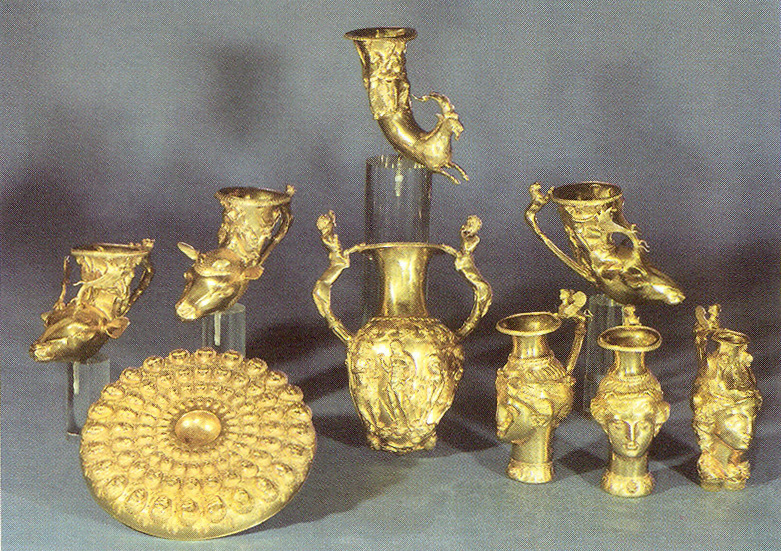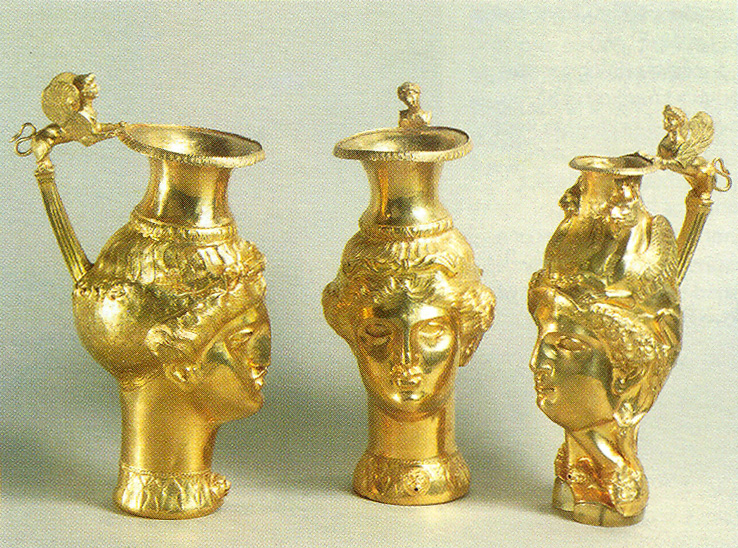The Accidental Discovery That Captivated the World
In the quiet Bulgarian town of Panagyurishte, the year 1949 marked the beginning of an extraordinary archaeological journey. Three brothers – Pavel, Petko, and Michail Deikov – were engaged in the mundane task of digging for clay to make bricks when their shovels struck something unexpected. Little did they know that their discovery would unveil a treasure trove of Thracian artifacts that would captivate the world.

As the brothers carefully unearthed their find, they were astounded by the brilliance of the objects before them. Nine vessels, crafted from pure 24-karat gold and weighing a total of 6.164 kilograms, emerged from the earth. This collection, soon to be known as the Panagyurishte Treasure, included a phiale (a shallow libation bowl), an amphora (a large jar used for storing and transporting liquids), three oinochoai (wine jugs), and four rhytons (ceremonial drinking vessels).
The Exquisite Golden Rhyton
Among these priceless relics, one piece stood out for its exceptional beauty and craftsmanship – a golden rhyton adorned with the head of a goddess or an Amazonian warrior. Dating back to the 4th-3rd century BC, this ceremonial drinking vessel became the centerpiece of the collection.

The rhyton is a unique and fascinating artifact that offers a glimpse into the sophisticated culture of the ancient Thracians. Rhytons were commonly used in religious ceremonies and rituals, serving as vessels for pouring libations or drinking sacred liquids. The intricate design and meticulous craftsmanship of the Panagyurishte Rhyton suggest that it was not just a functional object, but a work of art imbued with symbolic and spiritual significance.
The Thracian Legacy
The Thracians were a diverse group of Indo-European tribes that inhabited a vast region stretching from the Carpathian Mountains to the Aegean Sea, including modern-day Bulgaria, Romania, and parts of Greece and Turkey. Despite their significant contributions to the cultural and political landscape of the ancient world, the Thracians have often been overshadowed by their more well-known neighbors, the Greeks and Romans.

The discovery of the Panagyurishte Treasure, however, has helped to shed light on the remarkable artistic and technological achievements of the Thracian civilization. The intricate gold artifacts, with their intricate designs and meticulous craftsmanship, demonstrate the Thracians’ mastery of metalworking and their keen eye for aesthetics.
The Symbolism and Significance of the Rhyton
The golden rhyton from Panagyurishte is particularly significant because it provides insights into the religious and cultural beliefs of the Thracians. The depiction of the goddess or Amazonian warrior on the rhyton’s surface suggests that it may have been used in rituals or ceremonies associated with female deities or warrior women.

In Thracian mythology, the goddess Bendis was a prominent figure, often associated with the moon, hunting, and warfare. The Amazons, a legendary tribe of fierce female warriors, also held a prominent place in Thracian lore. The imagery on the rhyton may have been a representation of these powerful female figures, underscoring their importance in Thracian religious and cultural traditions.
The rhyton’s function as a ceremonial drinking vessel also carries symbolic significance. In many ancient cultures, the act of drinking from a sacred vessel was believed to have spiritual and transformative properties, allowing the individual to commune with the divine or experience altered states of consciousness.
The Ongoing Significance of the Panagyurishte Treasure
The discovery of the Panagyurishte Treasure, and the golden rhyton in particular, has had a lasting impact on our understanding of Thracian culture and the ancient world. The artifacts have been the subject of extensive research and analysis, shedding light on the technological, artistic, and religious practices of this enigmatic civilization.

Today, the Panagyurishte Treasure is housed in the National Archaeological Museum in Sofia, Bulgaria, where it continues to captivate and inspire visitors from around the world. The golden rhyton, with its intricate design and rich symbolism, stands as a testament to the ingenuity, creativity, and cultural sophistication of the ancient Thracians.
Conclusion: Unlocking the Secrets of the Past
The accidental discovery of the Panagyurishte Treasure in 1949 was a serendipitous moment that has had far-reaching implications for our understanding of the ancient world. The golden rhyton, with its exquisite craftsmanship and powerful symbolism, has become a symbol of the Thracian legacy, reminding us of the remarkable achievements and cultural richness of this often-overlooked civilization.
As we continue to explore and unravel the mysteries of the past, the Panagyurishte Treasure and the golden rhyton serve as a powerful reminder of the transformative power of archaeology. By unearthing and studying these ancient artifacts, we not only gain a deeper appreciation for the past, but we also unlock the secrets that can help us better understand the present and shape the future.

